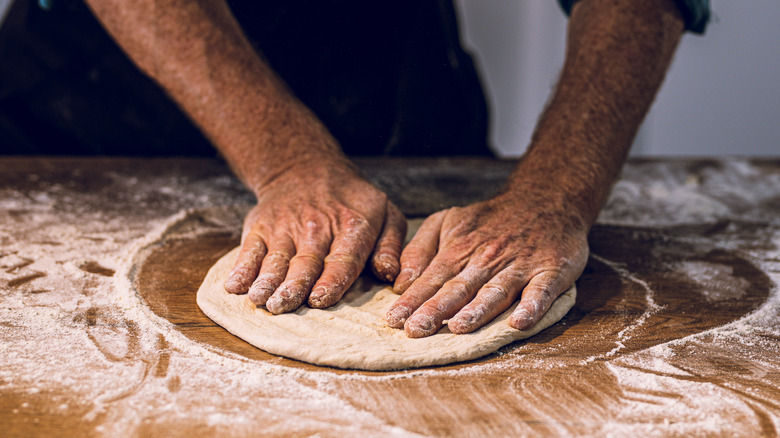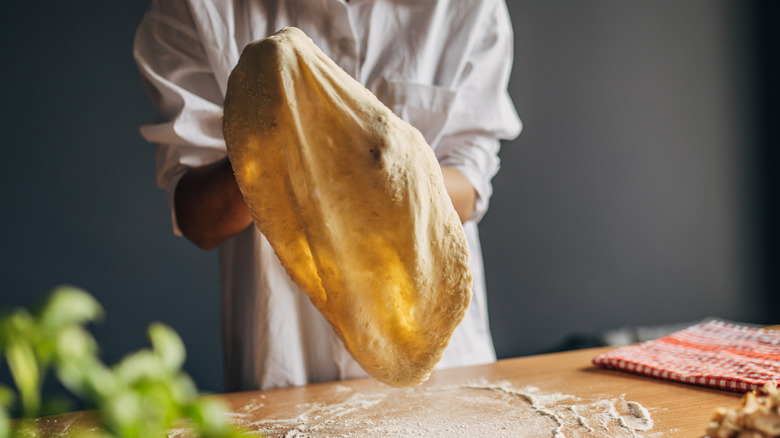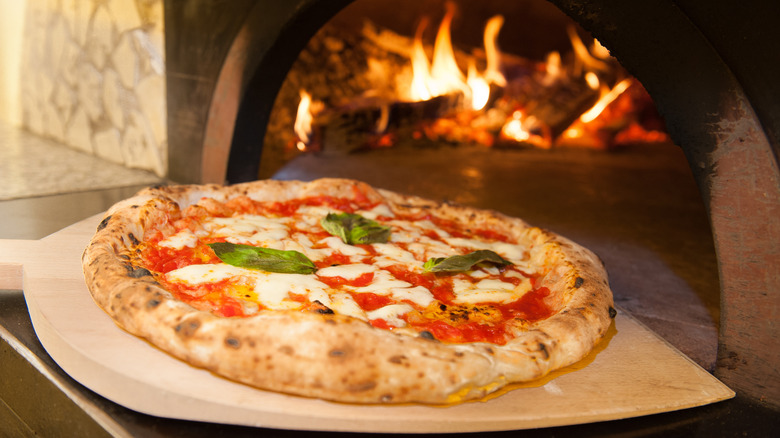The Biggest Mistake That's Sabotaging Your Homemade Pizza
A rolling pin might look like a time saver when you're whipping up some from-scratch pizza dough, but think twice before you use this tool. There's a reason why Italian pizzaiolos have been spreading dough out by hand for centuries: Unlike gradual and gentle stretching with your fingers, a rolling pin is one of the easiest ways to ruin pizza dough because it flattens the crust too much.
The most immediate damage a rolling pin will do to your pie is pushing the air bubbles out of the dough. Think for a moment about the texture of an excellent pizza crust. It should be crisp on the outside and tender on the inside, with an airy crumb. Kneading the dough works in all that precious air, but when flattered by a rolling pin, the final crust won't be able to puff up. Instead, you'll be left with a tough texture that resembles a cracker.
Rolling pins are also inefficient at stretching out the dough. The force of the hard pin can create tears in the crust, which leads to more time kneading it back together. It can also make the dough bunch up or shrink backward as you press it out. Do right by your pie and learn how to really stretch out the dough — the effort is well worth it.
How to stretch pizza dough without a rolling pin
Stretching the crust out by hand might seem intimidating, but with just a little bit of practice, you can get it down and avoid the mistakes everybody makes with their homemade pizza dough. No, you won't have to toss the pizza up in the air and spin it around on your knuckles like a pro — there are more user-friendly methods. Start by letting your dough come up to room temperature, making it more pliable and easier to handle. Next, ensure your counter is liberally dusted with flour. Without it, the dough will easily stick to your workspace.
Gently press down on your ball of dough and then flip it over to repeat the process. Take this newly-formed disk, hold the outer edge with both hands, and begin gently turning it in a circular motion. As you grip the edge and keep turning, gravity will help the dough stretch out. Once you've reached the desired size for your pie, carefully lay the dough flat and prepare to top it. Stretching from the outside like this ensures that the pizza forms evenly; if you stretch the dough by pulling the inside outwards, it can easily tear or turn out too thin in certain areas.
How to prepare and cook your pizza dough
After stretching out your dough, it's time to top it, and you want to continue treating the crust with respect by using other ingredients wisely. Depending on which of the many types of pizza you're making, you'll want to mind the amount of sauce. A Philadelphia-style tomato pie will need a generous layer, while a classic Neapolitan pie uses much less – but no matter what, don't ruin your hard work by adding so much sauce that the dough becomes soggy.
Similarly, choose your toppings wisely and don't overcrowd the pie. This can also lead to a waterlogged crust (especially if you use watery mushrooms or greens), not to mention a clashing flavor profile. As for baking, restaurants use high-output ovens to cook pizza at scorching temperatures that home ovens can't match. Fortunately, using a pizza stone can help compensate for this imbalance.
Simply put the stone in your oven while it's preheating, and the material will absorb the heat. When you place a pizza on top, this heat transfers upwards into the dough. The pizza will cook more quickly and evenly this way, with the crisp finish you've been after this whole time. If you don't have a pizza stone, reach for a rimmed sheet pan. Flip the pan over, and preheat it like you would a stone. While it won't perform quite as well, the sheet will still absorb and transfer heat to the dough.



